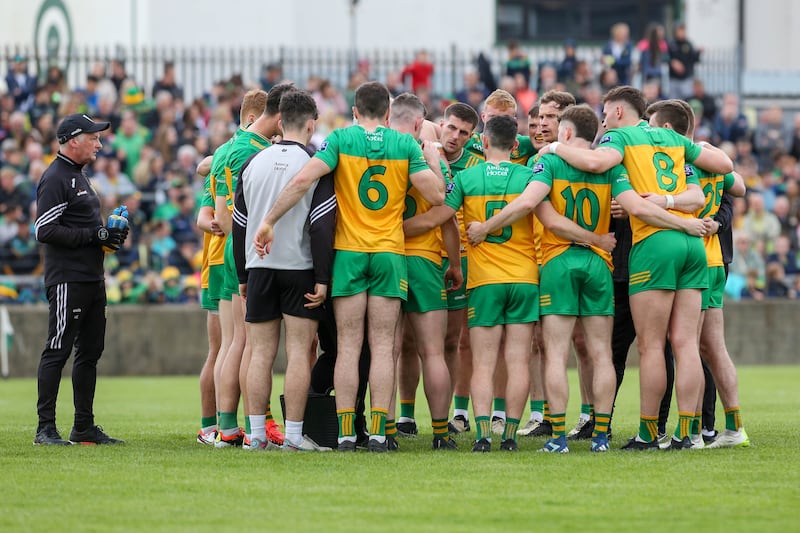One narrative all the way into the match at the weekend was that this was a perfect smash-and-grab opportunity for Tyrone: four weeks off, they had Donegal’s number the first time around, possibly resulting in nervousness for Jim McGuinness’s side combined with the comedown from the Ulster final win.
I didn’t really subscribe to those concerns simply because of the consistency of McGuinness’s messaging that by winning Ulster you would see a different Donegal, one brimming with confidence that they belonged in the All-Ireland series.
Afterwards, he was speaking about the team playing with a “bit of abandon” – suggesting the shackles are now off after navigating the Ulster championship. The team’s strength is their belief and a level of conditioning I didn’t think they’d reach for another year.
Players on Jim’s teams benefit from the clarity of his messaging and knowing exactly what their role is in the overall scheme. But Donegal are also exhibiting the great asset of confidence in what they are doing – an ingredient that is priceless as we go into this time of year.
READ MORE
Tyrone were still hanging in there until Donegal surged into that moving quarter, just after half-time. They won the second half, all in, 0-11 to 0-5. From the 50th minute on, it was death by 1,000 cuts: attacking incisions, a much more aggressive press on the kick-out and defensive turnovers.
We had two teams who will be playing in Division One next year but one team had genuine and complete belief and clarity about where they were going.
I could tell from my experience that Donegal’s players were now living the pictures that McGuinness has been painting in their heads during training in Convoy since last October. They’re constantly encountering those different scenarios in every game.
I remember the sense of empowerment that all of that work that you’ve been doing is coming to fruition on the pitch. You’ve trained for situations that are now happening.
On Saturday, look at the switch of Peadar Mogan – maybe the championship’s outstanding wing back so far – to corner back to mark Darren McCurry. That epitomised the daring of the team, doing something unexpected or counterintuitive as well as showing management’s belief in the group.
I could imagine these pictures being painted during the week: you’re going to put him on the back foot and he’s going to have to chase you around MacCumhaill Park, which will keep him as far away from the scoring zone as possible. They’ll be taking him off in the second half.

All of those things happened. The Tyrone corner forward, who’s a former All Star, got two points from play but Mogan outscored him with three plus a number of assists and McCurry was off after 51 minutes. These are the pictures that the players visualise during the week and when they see the predicted things happen, that’s the definition of buy-in.
In a strange way, it’s the best way of defending. We think of defence as backs making interventions to counter opposition forwards. What’s happening here is that you’re obliging that forward to defend by taking him out of the comfort zone when you have defenders like Mogan and Brendan McCole, who are always ‘on’ to break forward.
This is the new method of defending, as opposed to guarding the scoring zone with double sweepers and doubling up, tactics that are actually getting trickier and trickier anyway because referees are quicker to whistle fouls in congested areas. There are also less kicking and fewer contestable possessions for defenders to get stuck into.
Galway are interesting in that they do the opposite. Damien Comer has licence to stay up front and not track back, as we famously saw against Derry in the 2022 All-Ireland semi-final, but Pádraic Joyce has a unit of solid, specialist defenders. Donegal at the weekend had five backs. Everyone, bar McCole, could each play in the half forwards.
Anyway, bottom line: it’s another game – the fourth – without Donegal conceding a championship goal.
The crowd in Ballybofey was more than 16,000 and the place was hopping. There was a fair amount of comment on the fact that the attendance in Croke Park for Dublin-Roscommon was smaller and had all the atmosphere of a waiting room.
When you’re trying to showcase the game across the globe as well as across the country, it’s not a great look to tune into an empty stadium. It’s a diminished experience for the crowd attending and players are conscious of the flat occasion. Not ideal for anyone, including the television viewership, who are watching a supposed sporting spectacle with no crowd and wondering is this really that important.
I know there’s an issue because Dublin have designated Croke Park their home venue and the other ground in the city, Parnell Park has only recently been reduced to a capacity of below 10,000. But, in general terms, criteria for venues must be re-evaluated.
Until now it has been a Leinster Council matter and they must surely be reconsidering where they stage Dublin matches but we are now in the All-Ireland stages and should be putting the best foot forward.
Then, there’s scheduling. Leinster were in the European rugby final on Saturday and ended up in extra time clashing with Dublin’s opening All-Ireland fixture. This weekend, some matches are going up against the Champions League.
The new championship format is so condensed that surely there could be another look at putting matches on a Friday evening between neighbouring counties. We are watching underage matches all week on TG4 often getting great crowds.
It’s tricky in terms of welfare and work arrangements for players and I get that but from a promotional perspective, we should be giving ourselves the best chance.


















